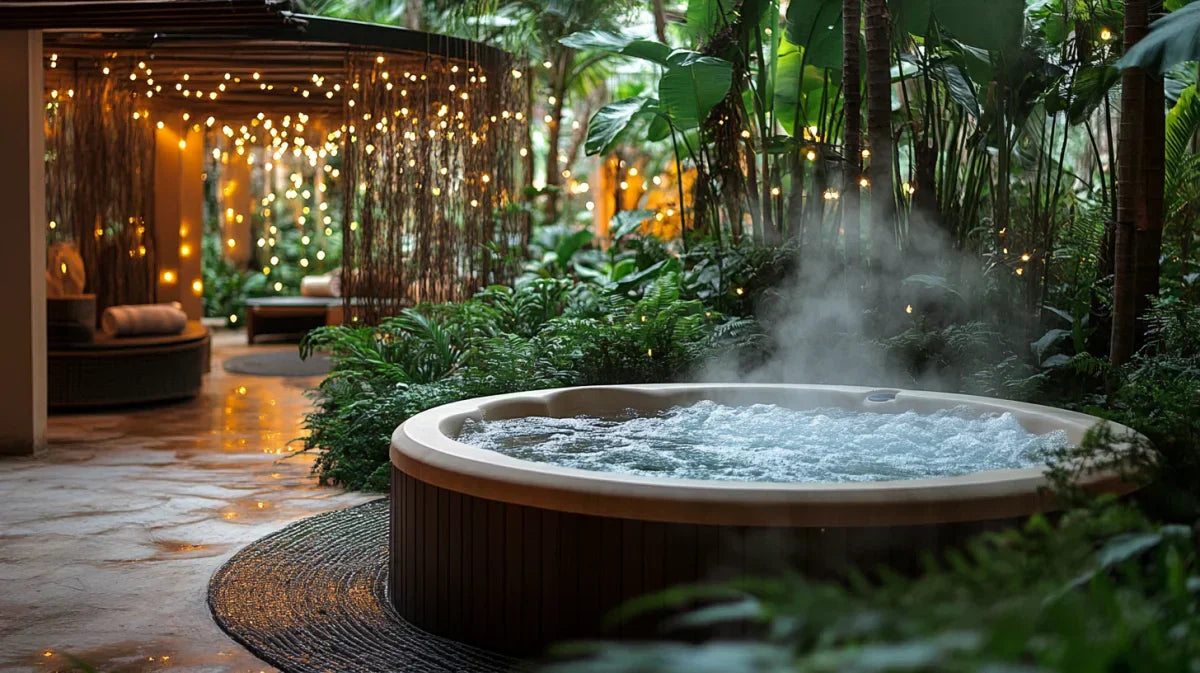Pregnancy is an exciting time full of changes for expectant mothers. As your body grows and changes to accommodate your developing baby, you may find that things that once brought you comfort and relaxation no longer feel safe. One common question that pregnant women have is whether it's okay to use a hot tub during pregnancy.
What Are the Concerns About Hot Tubs When Pregnant?
Hot tubs heat water to temperatures ranging from 98–104°F (37–40°C). Immersing your body in hot water for a prolonged period causes an increase in your internal body temperature, a condition known as hyperthermia. When you're pregnant, raising your core body temperature too high can potentially harm your developing baby.
Here are some of the possible risks associated with hot tub use during pregnancy:
- Neural tube defects: Exposure to high heat early in pregnancy may increase the risk of neural tube defects. The neural tube forms during the first month of pregnancy and goes on to develop into your baby's brain and spinal cord. Defects can result in disorders like spina bifida.
- Miscarriage: Some studies have found a link between hot tub use in early pregnancy and an increased risk of miscarriage. It's theorized that elevated body temperature could potentially damage and impair development during this critical stage.
- Birth defects: High heat exposure may also be associated with certain birth defects. The concern stems from the fact that vital organ development occurs during the first trimester.
- Preterm birth: Hyperthermia puts stress on the mother and fetus and may increase the risk of preterm labor and early delivery.
- Low birth weight: Getting overheated in a hot tub raises the mother's core temperature, which may affect the baby's growth and result in restricted fetal growth.
The risks are highest when hot tub use occurs early in pregnancy, especially during organogenesis in the first trimester. However, caution is recommended throughout pregnancy.
Are Hot Tubs Safe in Late Pregnancy?
Many pregnant women wonder if hot tub use is safer later in pregnancy, as the baby's major organs have fully formed by the second trimester. However, experts still recommend avoiding hot tubs during the third trimester as well.
Here's why hot tubs may still be risky even after your first trimester:
- Elevated body temperature continues to pose concerns like preterm labor, restricted growth, and low birth weight.
- The hot water can cause blood vessels to dilate, which may lower your blood pressure to dangerous levels. Blood pressure naturally drops during pregnancy, making expectant mothers prone to dizzy spells.
- Sitting in hot, swirling water increases the risk of getting overheated and dehydrated. This can reduce blood flow to the uterus.
- The hot temperatures make it harder for your body to shed heat as efficiently.
While the risks may be lower compared to early pregnancy hot tub use, experts encourage full avoidance as even occasional use could potentially impact your health and your baby's.
Guidelines for Hot Tub Use When Pregnant
Most doctors and healthcare providers recommend completely avoiding hot tubs during pregnancy as the safest option. No published studies have determined a “safe” duration or temperature for hot tub use in pregnancy.
However, if you're considering using a hot tub while pregnant, the American Pregnancy Association offers these precautions:
- Limit use to 10 minutes at a time. Get out immediately if feeling overheated.
- Keep the temperature below 100°F (38°C). Measure it with an accurate thermometer.
- Stay hydrated by drinking water before, during, and after use.
- Avoid hot tubs in the first trimester when risks are highest.
- Avoid using a hot tub after exercising or while under the influence of drugs or alcohol, as these increase health hazards.
- Consult your doctor about your individual risks before using a hot tub while pregnant. People with health conditions like high blood pressure are advised to avoid it completely.
The safest approach is to avoid hot tubs during pregnancy. But if you plan to use one anyway, be cautious by lowering the temperature, limiting time inside, staying hydrated, and getting approval from your healthcare provider first.
Are Hot Tub Chemicals Safe During Pregnancy?
In addition to the high heat, another concern with using hot tubs while pregnant is exposure to chemicals in the water. Hot tubs contain sanitizing chemicals like chlorine and bromine to eliminate bacteria that can cause infections. But are these chemicals safe for pregnant women and developing babies?
How Hot Tub Chemicals Affect Pregnancy
Most experts advise avoiding hot tub chemical exposure during pregnancy when possible. Here's a look at how the chemicals may impact you and your baby:
Chlorine
- Chlorine is the most common hot tub disinfectant. At low levels, it should not harm pregnant women.
- However, at high concentrations or with prolonged exposure, chlorine may irritate your skin, eyes, and mucous membranes. This could potentially increase pregnancy discomfort.
- Swallowing chlorinated water can cause gastrointestinal issues like nausea and vomiting.
- Studies on chlorine and pregnancy risks show mixed results, so many doctors recommend caution.
Bromine
- Like chlorine, bromine is an effective disinfectant for hot tubs at low doses.
- In high amounts, it may irritate your airway and make breathing difficult.
- Bromine ingestion can cause nausea, vomiting, and diarrhea.
- There is limited research on bromine and pregnancy. But because it's chemically similar to chlorine, potential risks may also be similar.
Other chemicals
- Sanitizers like hydrogen peroxide and mineral purifiers may be safer alternatives during pregnancy. However, they are less common in hot tubs.
- Ozone systems help sanitize hot tubs via ozone gas but may be unsafe as it can irritate lungs when inhaled.
The takeaway is that chlorine and bromine at low, well-regulated levels are generally not thought to be harmful. However, research has not determined completely safe levels. So most providers encourage pregnant women to minimize exposure.
Precautions for Hot Tub Chemical Exposure
To lower the risks of chemical exposure from using a hot tub while pregnant:
- Avoid getting in the hot tub right after chemicals have been added and chlorine/bromine levels are high.
- Only use a hot tub where sanitizer levels are carefully monitored and kept within recommended ranges.
- Shower immediately after getting out of the hot tub to wash any chemicals off your skin.
- Avoid swallowing any hot tub water, as ingesting chemicals is the most dangerous exposure route.
- Get out right away and rinse off if your skin or eyes feel irritated, as this could indicate high chemical levels.
Along with these precautions, discussing hot tub chemical use with your doctor can help you make an informed decision about potential pregnancy risks. Many simply advise avoiding hot tubs completely to be safest.
Are Saltwater Hot Tubs Safer During Pregnancy?
Saltwater hot tubs are a potential alternative for pregnant women wanting to enjoy hot tub benefits while minimizing risks. But are saltwater hot tubs actually safer to use during pregnancy?
How Saltwater Hot Tubs Work
Saltwater hot tubs work by adding and dissolving salt (sodium chloride) into the water instead of harsh chemicals. The salt-infused water passes through an electrolytic generator containing electrodes.
This creates a process called electrolysis which separates the salt's sodium and chloride ions. The sodium and chloride atoms then rearrange to create hypochlorous acid, a natural disinfectant.
The hypochlorous acid sanitizes the tub without requiring large amounts of added chlorine or other chemicals. The salt content is generally around 1,500–3,000 ppm. Seawater is about 35,000 ppm for comparison.
Potential Advantages of Saltwater Hot Tubs
Here are some possible advantages of using a saltwater hot tub while pregnant:
- Gentler on skin and eyes: The hypochlorous acid is gentle and non-irritating compared to chlorine irritation.
- Lower chemical content: Saltwater hot tubs only need minimal added chlorine or bromine to maintain proper sanitizer levels. The salinated water helps reduce chemical exposure.
- May allow shorter, cooler soaks: Due to lower chemical concerns, some providers say short saltwater hot tub soaks at lower temperatures may be okay.
- Easier maintenance: Saltwater hot tub water usually requires less frequent monitoring and chemical balancing.
The biggest advantage is that saltwater soaks likely pose less potential risk from harsh sanitizing chemical exposure. But risks from heat and prolonged immersion would still apply.
Precautions for Using Saltwater Hot Tubs
While saltwater hot tubs have some advantages, exercise these precautions as well:
- Stay well-hydrated before, during and after use to prevent dehydration and dizziness.
- Monitor your body temperature and get out immediately if feeling overheated.
- Limit soak time to 10 minutes or less.
- Consult your doctor about safe timing and usage. Avoid use in the first trimester.
- Measure and keep the water temperature under 100°F (38°C).
- Avoid entry after recent sanitizer additions until levels stabilize.
- Rinse off after getting out to remove any residual chemicals on your skin.
- Salt levels should be kept in the ideal range. Too little salt prevents proper sanitization, while too much can irritate eyes.
While thought to be safer, saltwater hot tubs still pose some health concerns during pregnancy. Discuss proper usage with your doctor and follow usage guidelines to reduce risks. Or avoid hot tub use entirely for maximum safety.
Are Infections a Concern With Hot Tubs and Pregnancy?
Using a shared public hot tub raises the risk of developing infections during pregnancy. Hot tubs can harbor bacteria, viruses, and parasites that cause illnesses. Are hot tub infections a legitimate concern for expectant mothers?
Common Hot Tub-Related Infections
Hot tubs, especially poorly maintained communal ones, may spread infections like:
Legionnaires’ disease
- Caused by Legionella bacteria
- Triggers pneumonia-like symptoms
- Elderly and pregnant women are high-risk
Hot tub rash
- Folliculitis skin infection from Pseudomonas bacteria
- Causes an itchy, red, pimple-like rash
Urinary tract infections (UTIs)
- E. coli, Klebsiella, and other bacteria can cause UTIs
- Pregnant women already at higher risk
Nontuberculous mycobacteria (NTM)
- Slow-growing organisms found in water that can infect lungs
- Causes a type of pneumonia
Properly cleaned and sanitized hot tubs should not spread illnesses. But bacteria and other microbes thrive in inadequately treated hot tubs, especially public hot tubs with many users.
Minimizing Infection Risk
Here are some tips pregnant women can follow to reduce the risk of developing hot tub-related infections:
- Only use your personal home hot tub if you maintain it properly.
- Avoid using public, hotel, gym, or shared hot tubs. You cannot control the maintenance.
- Shower with soap before entering a hot tub.
- Keep your head above water to prevent swallowing germs.
- Don’t sit with the jets directly hitting your body. Keep space between you and the jets.
- Never enter a hot tub if it looks dirty, cloudy, or smells strongly of chemicals.
- Rinse off immediately after exiting a hot tub.
- See a doctor for evaluation if you develop any skin issues, respiratory symptoms, or other concerns after hot tub use during pregnancy.
In addition to these tips, avoiding hot tubs altogether if you are pregnant prevents exposure to water-borne pathogens. Consult your doctor about how to protect against infections if planning hot tub use while expecting.
Are Warm Baths a Safer Alternative During Pregnancy?
Many pregnant women still want to enjoy a relaxing warm soak during pregnancy but are unsure about hot tub safety. An alternative is to take a warm (not hot) bath instead. Are baths safer than hot tubs for expecting mothers?
Benefits of Warm Baths During Pregnancy
There are several advantages to enjoying a warm bath instead of hot tub use when pregnant:
- Better temperature regulation: Baths heat your body more gradually so you don't get dangerously overheated.
- Lower risk of dehydration: Baths don't cause as much fluid loss compared to being immersed chin-deep in a hot tub.
- Avoid harsh chemicals: Baths only use gentle soaps and require no added sanitizers.
- Lower infection risk: Private baths you clean yourself limit pathogen exposure compared to public hot tubs.
- Easier precautionary steps: You can control the temperature, hydration, duration, and cleaning of your own bath.
- Hydrotherapy benefits: Warm water can relax muscles, reduce swelling, and ease aches/pains of pregnancy without danger of overheating.
For women wanting to soak during pregnancy, a warm (not hot) bath may provide some of the same relaxation and hydrotherapy benefits as a hot tub in a safer manner.
Precautions for Pregnancy Baths
To make bathing as safe as possible during pregnancy:
- Monitor the temperature and only fill the tub with warm, not hot water. Ideal is around body temperature.
- Limit baths to 10-15 minutes to prevent overheating. Get out sooner if feeling dizzy or overheated.
- Stay well-hydrated by drinking water before, during, and after.
- Add cool water if needed to prevent the bath from heating your body too much.
- Avoid exceptionally long soaks exceeding 15-20 minutes.
- Use minimal soaps/products to prevent irritation and as they can enter the vagina.
- Keep baths a comfortable temperature – warm but never hot.
Consult your doctor about safe bathing, as some may advise against baths later in pregnancy when the risk of infection increases. But in general, warm short baths are considered safer than hot tubs when expecting.
Hot Tub Use After Pregnancy
While pregnant women need to take care to avoid risks like overheating, exposure to chemicals, dehydration and infections that hot tubs can potentially pose, the dangers dissipate for mothers after giving birth. Hot tub manufacturers recommend waiting until 6 weeks after delivery to allow time for healing before returning to hot tub use. Here are some benefits new mothers may gain from soaking in a hot tub after pregnancy:
Postpartum Relaxation
The warm, massaging waters of a hot tub can soothe both body and mind after labor and delivery. This can provide much-needed relaxation and escape for busy new moms.
Sore Muscle Relief
If you experienced muscle strains or tears during delivery, the hot temperatures and jetted water can promote healing blood flow and relax tense muscles.
Improved Breastfeeding
Some lactation consultants and doctors recommend bringing nursing babies into a hot tub with mom. The skin-to-skin contact in warm relaxing water may improve milk production and breastfeeding.
Weight Loss Aid
Many women struggle to lose pregnancy weight after baby. The combination of heat, massage and buoyancy makes it easier to exercise sore post-pregnancy bodies in a hot tub. This can support postpartum fitness and weight loss efforts.
Bonding Time
Sharing a warm hot tub with your partner and new baby offers a chance to bond and reconnect as a family. The intimate setting often encourages relaxation, conversation, and quality time together.
Improved Sleep
Soaking in a hot tub before bedtime raises your core body temperature. As you get out and that warmth radiates off your body, the rapid cooling effect helps signal your brain that it's time for bed. The improved sleep from this effect can be invaluable for sleep-deprived new parents.
Hydrotherapy Healing
The buoyancy and massage provided by hot water jets promotes increased blood flow throughout the body. This improves circulation and provides therapeutic benefits as the body recovers from pregnancy and childbirth.
Precautions for Postpartum Hot Tub Use
While hot tub benefits abound after giving birth, new moms should take some precautions as well:
- Wait until at least 6 weeks after delivery before hot tub use to allow healing. Get your doctor's approval, especially if you had a C-section, tear, or other complications.
- Keep time spent in the hot tub to 10 minutes or less to prevent dehydration, dizziness, or nausea.
- Avoid entry right after chemical sanitization until levels balance out to prevent irritation.
- Lower hot tub temperatures to 100°F or less if bringing your baby into the water with you.
- Prevent infections by keeping hot tubs well-maintained, showering before use, and avoiding swallowing any water.
- Stay hydrated by drinking water before, during and after hot tub use.
- Never use a hot tub while under the influence of drugs, alcohol or medications that cause drowsiness.
With some common-sense precautions, enjoying your home hot tub after pregnancy can be a safe way for new mothers to relax, heal and spend quality time with baby. Just be sure to check with your doctor and follow usage guidelines.
Important Hot Tub Health and Safety Reminders
Pregnant women need to take extra health and safety precautions when using a hot tub. But some key safety tips apply to all hot tub users:
- Check hot tub water chemistry routinely and adjust chemicals like chlorine within recommended ranges.
- Test water temperature regularly and keep hot tubs under 104°F (40°C).
- Shower before hot tub use to avoid contaminating the water with sweat, dirt and body oils.
- Keep head and hair above water to avoid ingestion of chemicals and bacteria.
- Hydrate well before, during and after hot tubbing. Have water readily available.
- Avoid alcohol consumption before or during hot tub use as it increases health risks.
- Prevent children from access to hot tubs without adult supervision.
- If feeling dizzy, nauseated or unwell, exit the hot tub immediately and cool down.
- Consult your physician about any health conditions like heart disease, pregnancy complications or medications that may restrict hot tub usage.
- Follow the manufacturer’s instructions for your particular hot tub model and all warnings.
Final Word
Remember, hot tubbing provides benefits like relaxation and hydrotherapy. But staying mindful of precautions enhances safety for all users, especially pregnant women and children. Maintain hot tubs properly and use good judgment.



